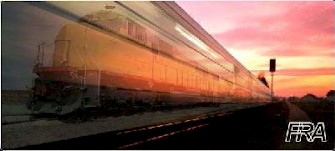Happening Now
Creating Space - San Francisco to Salt Lake City
August 9, 2013
Written By Malcolm Kenton
This morning, the Millennial Trains Project group finally boarded our three private cars to head eastward (on-time) out of Emeryville, CA (directly across the Bay from San Francisco). Our original plan was to spend last night aboard the cars at the Oakland yard, but a mishap with Amtrak security forced us to find alternate accommodations. We wound up at the Marin Highlands Hostel, just across the Golden Gate Bridge, and started the day with group stretching and a group photo on a misty bluff overlooking the Bridge, the SF skyline, and the sweep of the Bay. At one point, rays of sunshine peaked through the thick clouds at the east--a good omen for our journey.

The bulk of the rest of the day has been spent hearing from two guest mentors and having wide-ranging discussions on the ways and means of effecting positive change on a variety of fronts while faced with the complexities and distractions of the modern world. All this took place in an incomparable setting: an original 1940s streamlined California Zephyr dome car, the Silver Lariat, on its home rails--while traveling along the Carquinez Strait, through Central Valley farmland, and climbing into the high Sierras, following rushing streams of clear water while gazing at the lofty peaks above.
Eric Kessler, our first speaker, was a major player in the environmental movement in the 1980s and early 90s, and now runs a company that advises wealthy philanthropists on how to do the most good with their money. For any social endeavor to be effective, he said, it must know how to measure success, and it must show its funders that it is achieving what it set out to do via the metrics it established. This, he said, is the way the likes of Bill Gates and Warren Buffett (both of whom are Kessler's clients) approach philanthropy.
I interviewed Kessler for our film during the lunch break, and he had great advice for where NARP can look for useful advice on our task of making trains "cool" to a broader section of Americans and translating the existing demand for train travel--which already outpaces the supply that undercapitalized Amtrak can offer--into a forceful movement to convince elected officials that properly funding trains is not a controversial matter.
After lunch, Mike Zuckerman, the founder of Freespace and one of the people behind the Civic Hacking movement, spoke of the importanceof Ray Oldenberg's concept of a "third place," other than one's home and work, that provides a welcoming home for people of different backgrounds to interact--a place people to because they want to be there. Society and democracy are better off when third places abound, he declared.
This got me thinking about how much trains--particularly long-distance trains with dining and lounge cars--serve as third places that connect people not only across different backgrounds, but also across physical space. The space that trains provide for both social and individual activities that our modern lifestyles tend to leave too little time for is an important, and often overlooked, benefit of having a functioning intercity train network.
A final lesson from Zuckerman's talk: Change doesn't just come from people who are working. It can also come out of people relaxing and having a good time.
-- Malcolm Kenton
"We would not be in the position we’re in if it weren’t for the advocacy of so many of you, over a long period of time, who have believed in passenger rail, and believe that passenger rail should really be a part of America’s intermodal transportation system."
Secretary Ray LaHood, U.S. Department of Transportation
2011 Spring Council Meeting
Comments